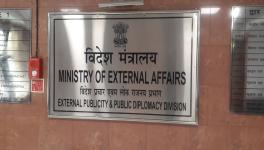Myanmar in Indian Foreign Policy’s Blindspot
The conflict in Myanmar following the coup is approaching a crucial point as the military and the resistance have both upped the ante. Anthony Davis on October 19, 2021 in Asia Times released the details of the military’s Operation Anawrahta (named after the warrior founder of the Burmese kingdom), lanched to crush the resistance across the country—from the Irrawaddy valley to the borderlands. Photos of houses burning in Chin state’s Thantlang after the Myanmar army’s shelling of the town testify to the escalation of violence against the citizens along the Myanmar-Indian border. This has triggered a new wave of refugees’ movement into Mizoram. However, the Indian state’s position on Myanmar has remained passive, hidden behind ASEAN’s five-point consensus, and letting the conflict play out.
More Violence at the Horizon
Though the objective of Operation Anawrahta is seemingly to retake control of all the territory, the Myanmar army, with decades of experience in counter-insurgency operations, knows that it is easier said than done. The more practical aim of the operation might be to spread the fear of the army among people. However, the resistance, led by the National Unity Government (NUG), which declared people’s defence war on September 7, 2021, has now organised a Central Command and Coordination Committee (C3C) along with Ethnic Armed Organisations (EAOs) to fight the military. This is a major step towards organising the armed struggle, and providing leadership to several inexperienced People Defence Forces (PDFs) across the country. The international and regional communities’ general lack of initiative to mitigate the conflict means that there are limited, if any, external factors that could restrain the upcoming wave of human tragedy.
Apathetic and Passive Policy
India’s hands in this violence are not clean either. The government abstained from voting on a UN General Assembly resolution seeking a non-binding arms embargo on Myanmar. Bharat Electronics Limited (BEL) has continued to ship radar components that help in coastal surveillance even after the coup. Such double standards reflect that the Indian government is merely paying lip service to democratic transition in Myanmar and has in effect sided with the military under Min Aung Hlaing (MAH).
The Indian embassy’s military attaché attended the Armed Forces Day parade in March, which was by far the bloodiest day in the conflict. While this may have been merely coincidental and not an endorsement of the coup, it signals poor diplomatic handling. Further, the Union government’s directions to deny asylum to the incoming refugees and general apathy towards the long-running Rohingya crisis erode India’s normative stance on the issue. Such a stance also ignores the kinship linkages that run across the border, especially between India’s Mizoram and Myanmar’s Chin state.
The Limits of ASEAN’s Approach
So far, the government’s policy has been to take a back seat and stand behind ASEAN’s five-point plan. ASEAN lobbied against the UNGA resolution on the arms embargo and even allowed the military to attend its meetings. However, recently there has been a shift, though it has little substantial relevance. ASEAN’s decision to allow only a ‘non-political representative’ from Myanmar instead of MAH is seen as a snub to the military. This comes as a response to MAH’s decision to deny the ASEAN envoy the opportunity to meet Aung San Suu Kyi. ASEAN’s Five-point plan has come under great scrutiny for being weak and not holding the military responsible. The delay in the appointment of the special envoy (Brunei’s Erywan Yusof), the subsequent restrictions put on his visits, and now murmurs of a new appointment bring forth the hollowness of the initiative. India, on the issue of Myanmar, has consistently reinstated its support for this initiative.
What Must be Done?
Generations of people in Myanmar have suffered due to military rule and ethnic conflicts. Even in the brief period of democratic transition under Thein Sein and the National League for Democracy, the Rohingya crisis spiralled and new faultlines replaced a few old ones. The United States and Europe have traditionally dealt with Myanmar through the imposition of economic and trade sanctions—these had asymmetrically affected the people. The unregulated jade trade, trafficking in drugs, humans, and wildlife, and loss of life in conflict are bound to increase. Even if normative concerns do not drive Indian foreign policy, Myanmar is key to India’s Look/Act East policy and its plans for its North-eastern states. While the decision-makers in Delhi will find it challenging to look at Myanmar without the Chinese prism, India has starkly limited strategic and diplomatic depth compared to China in the country. Adani group’s recent announcement to end investments in the country testifies the same. Further, standing behind ASEAN’s plan does not achieve that end either.
India must recognise NUG as a stakeholder and actively engage with it. The growing convergence between NUG and EAOs also provide an opportunity to bridge decades-old trust deficits and create a unified political community for the future. This could be a moment that offers a practical shape to the spirit of the Panglong peace process. India should impose a moratorium on the selling of technology and arms to the military for now. Conditionalities can be drawn to bring participants to the table. Further, as Myanmar is again relegated off the high table of international politics, India must channelise the concerns of the people and ensure continued international engagement. While strategists might lose Myanmar in policy’s blindspot, the costs are bound to drastically rise if India continues to follow such an apathetic and passive policy.
Chetan Rana is a Ph.D. Research Scholar, Diplomacy and Disarmament at Centre for International Politics, Organisation, and Disarmament (CIPOD) in Jawaharlal Nehru University. He tweets at @ChetanRana96. The views are personal.
Get the latest reports & analysis with people's perspective on Protests, movements & deep analytical videos, discussions of the current affairs in your Telegram app. Subscribe to NewsClick's Telegram channel & get Real-Time updates on stories, as they get published on our website.
























